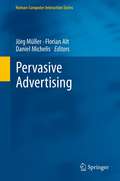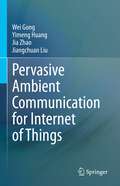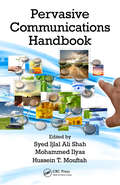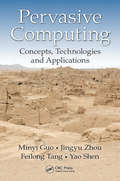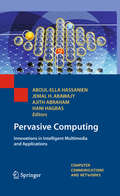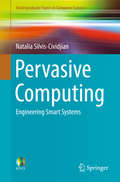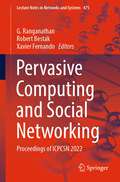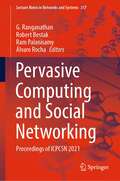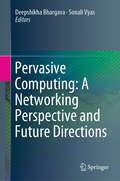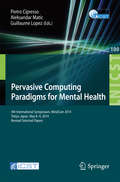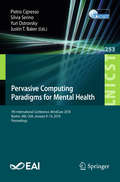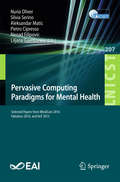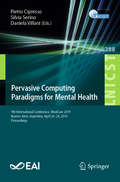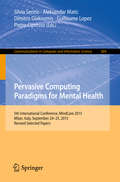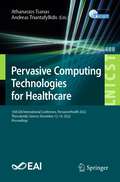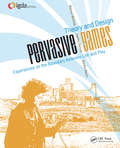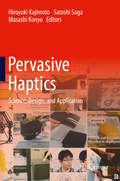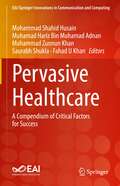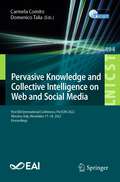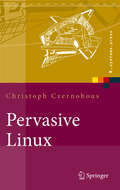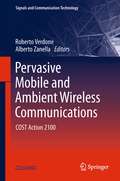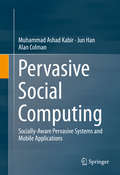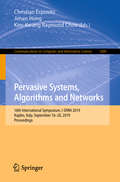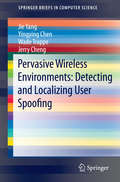- Table View
- List View
Pervasive Advertising
by Daniel Michelis Florian Alt Jörg MüllerThis book looks at the future of advertising from the perspective of pervasive computing. Pervasive computing encompasses the integration of computers into everyday devices, like the covering of surfaces with interactive displays and networked mobile phones. Advertising is the communication of sponsored messages to inform, convince, and persuade to buy. We believe that our future cities will be digital, giving us instant access to any information we need everywhere, like at bus stops, on the sidewalk, inside the subway and in shopping malls. We will be able to play with and change the appearance of our cities effortlessly, like making flowers grow along a building wall or changing the colour of the street we are in. Like the internet as we know it, this digitalization will be paid for by adverts, which unobtrusively provide us suggestions for nearby restaurants or cafés. If any content annoys us, we will be able to effortlessly say so and change it with simple gestures, and content providers and advertisers will know what we like and be able to act accordingly. This book presents the technological foundations to make this vision a reality.
Pervasive Ambient Communication for Internet of Things
by Wei Gong Yimeng Huang Jia Zhao Jiangchuan LiuThis book covers several essential aspects of pervasive ambient backscatter communication, one of the most cutting-edge technologies for Internet-of-Things. It begins with introductory Part I, which presents visions, basic concepts, principles, and paradigms of ambient backscatter. Also, a taxonomy of state-of-the-art ambient backscatter systems is provided from the perspective of the OSI model. Part II and III study how ambient backscatter systems work on the communication and networking levels. Specifically, Part II discusses in detail how to make use of ambient WiFi signals to provide high-throughput backscatter communications with WiFi 1 (chapter 5), WiFi 2-3 (chapter 4), WiFi 4 (chapter 3), WiFi 5-6 (chapter 6) standards. Further, Part III includes several of the most advanced ambient backscatter network solutions, which are made possible by the first multi-hop backscatter (chapter 7), first backscatter mesh (chapter 8), and multiprotocol backscatter (chapter 9). On top of reliable communication and networks, we propose two novel applications that are thought impossible before, lightweight spatial sound recording over the air (chapter 10) and self-powered wireless wearables for healthcare (chapter 11). To conclude the monograph, we point out critical challenges for realizing the vision of pervasive backscatter IoTs and potential directions of ambient backscatter applications. The book provides an in-depth understanding of ambient backscatter technologies. In particular, we mainly take ubiquitous WiF signals as the communication sources and adopt a top-down approach to introduce three crucial subjects: WiFi backscatter communication, ambient backscatter network, and self-powered application systems. For each subject, we carefully divide it into several relatively independent topics, which come with the latest advances in pervasive backscatter and include extensive discussions of closely related state-of-the-art methodologies.
Pervasive Communications Handbook
by Syed Ijlal Ali Shah Mohammad Ilyas Hussein T. MouftahIn an emergency, availability of the pervasive communications environment could mean the difference between life and death. Possibly one of the first guides to comprehensively explore these futuristic omnipresent communications networks, the Pervasive Communications Handbook addresses current technology (i.e., MAC protocols and P2P-based VoD architecture) and developments expected in the very near future, when most people and places will be virtually connected through a constant and perpetual exchange of information. This monumental advance in communications is set to dramatically change daily life, in areas ranging from healthcare, transportation, and education to commerce and socialization. With contributions from dozens of pioneering experts, this important reference discusses one-to-one, one-to-many, and many-to-one exchanges of information. Organized by the three key aspects—technology, architecture, and applications—the book explores enabling technologies, applications and services, location and mobility management, and privacy and trust. Citing the technology’s importance to energy distribution, home automation, and telecare among other areas, it delves into topics such as quality of service, security, efficiency, and reliability in mobile network design, and environment interoperability.
Pervasive Computing: Concepts, Technologies and Applications (Lecture Notes in Computer Science #6646)
by Minyi Guo Jingyu Zhou Feilong Tang Yao ShenThis book introduces fundamental concepts and theories in pervasive computing as well as its key technologies and applications. It explains how to design and implement pervasive middleware and real application systems, covering nearly all aspects related to pervasive computing. Key technologies in the book include pervasive computing-oriented resource management and task migration, mobile pervasive transaction, human computer interface, and context collection-oriented wireless sensor networks.
Pervasive Computing
by Aboul-Ella Hassanien Hani Hagras Ajith Abraham Jemal H. AbawajyThis volume provides state-of-the-art coverage of the diverse topics related to pervasive computing and intelligent multimedia technologies. The use of different computational intelligence-based approaches to various problems in pervasive computing are examined, including video streaming, intelligent behavior modeling and control for mobile manipulators, tele-gaming, indexing video summaries for quick video browsing, web service processes, virtual environments, ambient intelligence, and prevention and detection of attacks to ubiquitous databases. Topics and features: includes a comprehensive overview, providing a thorough literature review; examines virtual reality technology, and mobile virtual environments; describes various approaches in ambient intelligence for home health care for the elderly and those suffering from Alzheimer's disease, and for volcano monitoring; investigates issues in web services and situation awareness in pervasive computing environments; explores wireless network applications.
Pervasive Computing
by Natalia Silvis-CividjianThis book provides a concise introduction to Pervasive Computing, otherwise known as Internet of Things (IoT) and Ubiquitous Computing (Ubicomp) which addresses the seamless integration of computing systems within everyday objects. By introducing the core topics and exploring assistive pervasive systems which infer their context through pattern recognition, the author provides readers with a gentle yet robust foundation of knowledge to this growing field of research. The author explores a range of topics including data acquisition, signal processing, control theory, machine learning and system engineering explaining, with the use of simple mathematical concepts, the core principles underlying pervasive computing systems. Real-life examples are applied throughout, including self-driving cars, automatic insulin pumps, smart homes, and social robotic companions, with each chapter accompanied by a set of exercises for the reader. Practical tutorials are also available to guide enthusiastic readers through the process of building a smart system using cameras, microphones and robotic kits. Due to the power of MATLAB(tm), this can be achieved with no previous programming or robotics experience. Although Pervasive Computing is primarily for undergraduate students, the book is accessible to a wider audience of researchers and designers who are interested in exploring pervasive computing further.
Pervasive Computing and Social Networking: Proceedings of ICPCSN 2022 (Lecture Notes in Networks and Systems #475)
by G. Ranganathan Robert Bestak Xavier FernandoThe book features original papers from International Conference on Pervasive Computing and Social Networking (ICPCSN 2022), organized by NSIT, Salem, India during 3 – 4 March 2022. It covers research works on conceptual, constructive, empirical, theoretical and practical implementations of pervasive computing and social networking methods for developing more novel ideas and innovations in the growing field of information and communication technologies.
Pervasive Computing and Social Networking: Proceedings of ICPCSN 2021 (Lecture Notes in Networks and Systems #317)
by Álvaro Rocha Robert Bestak Ram Palanisamy G. RanganathanThe book features original papers from International Conference on Pervasive Computing and Social Networking (ICPCSN 2021), organized by NSIT, Salem, India during 19 – 20 march 2021. It covers research works on conceptual, constructive, empirical, theoretical and practical implementations of pervasive computing and social networking methods for developing more novel ideas and innovations in the growing field of information and communication technologies.
Pervasive Computing: A Networking Perspective and Future Directions
by Deepshikha Bhargava Sonali VyasThis book offers an accessible guide to ubiquitous computing, with an emphasis on pervasive networking. It addresses various technical obstacles, such as connectivity, levels of service, performance, reliability and fairness. The focus is on describing currently available off-the-shelf technologies, novel algorithms and techniques in areas such as: underwater sensor networks, ant colony based routing, heterogeneous networks, agent based distributed networks, cognitive radio networks, real-time WSN applications, machine translation, intelligent computing and ontology based bit masking. By introducing the core topics and exploring assistive pervasive systems that draw on pervasive networking, the book provides readers with a robust foundation of knowledge on this growing field of research. Written in a straightforward style, the book is also accessible to a broad audience of researchers and designers who are interested in exploring pervasive computing further.
Pervasive Computing Paradigms for Mental Health
by Pietro Cipresso Aleksandar Matic Guillaume LopezThis book constitutes revised post-proceedings of the 4th International Symposium on Pervasive Computing Paradigms for Mental Health, MindCare 2014, held in Tokyo, Japan, in May 2014. The 11 full and 5 short papers presented were carefully reviewed and selected from 26 submissions for inclusion in the proceedings. The papers are organized in topical sections on recognition and assessment, mental health management, improving communication, depression, and self-applied treatments.
Pervasive Computing Paradigms for Mental Health: 7th International Conference, MindCare 2018, Boston, MA, USA, January 9–10, 2018, Proceedings (Lecture Notes of the Institute for Computer Sciences, Social Informatics and Telecommunications Engineering #253)
by Pietro Cipresso Silvia Serino Yuri Ostrovsky Justin T. BakerThis book constitutes the refereed proceedings of the 7th International Conference on Pervasive Computing Paradigms for Mental Health, MindCare 2018, held in Boston, MA, USA, Jin January 2018. The 19 papers presented were carefully reviewed and selected from 30 submissions and present advanced computing and communication technologies from the use of wearable sensors and ecological virtual environments to use of big data and machine learning techniques. These technologies can be used to support and promote the well-being through an objective continuous data collection and personalized
Pervasive Computing Paradigms for Mental Health: 4th International Symposium, Mindcare 2014, Tokyo, Japan, May 8-9, 2014, Revised Selected Papers (Lecture Notes of the Institute for Computer Sciences, Social Informatics and Telecommunications Engineering #100)
by Liljana Gavrilovska Nenad Filipovic Pietro Cipresso Aleksandar Matic Silvia Serino Nuria OliverThis book constitutes the refereed proceedings of the 6th International Symposium on Pervasive Computing Paradigms for Mental Health, MindCare 2016, held in Barcelona, Spain, in November 2016, and the Second International Conference of Future Access Enablers of Ubiquitous and Intelligent Infrastructures, Fabulous 2016, Belgrade, Serbia, October 24-26, 2016, and the Third International Conference on Interoperability in IoT, IIoT 2015, Rome, Italy, October 26-27, 2015. The 24 papers were selected from 32 submissions. MindCare presents technologies in favor of maintaining and improving psychological well-being. Fabulous presents broad areas of future wireless networks, ambient and assisted living and smart infrastructures in order to interact, exchange ideas, expertise, experience and know-how. And finally IIoT presents tools and services in home automation and industrial service.
Pervasive Computing Paradigms for Mental Health: 9th International Conference, MindCare 2019, Buenos Aires, Argentina, April 23–24, 2019, Proceedings (Lecture Notes of the Institute for Computer Sciences, Social Informatics and Telecommunications Engineering #288)
by Silvia Serino Pietro Cipresso Daniela VillaniThis book constitutes the refereed proceedings of the 9th International Conference on Pervasive Computing Paradigms for Mental Health, MindCare 2019, held in Buenos Aires, Argentina, in April 2019. The 22 papers presented were carefully reviewed and selected from 38 submissions and present new paradigms in mental healthcare, in parallel with compelling questions about how it is possible to promote and structure these changes to improve physical well-being.
Pervasive Computing Paradigms for Mental Health
by Silvia Serino Aleksandar Matic Dimitris Giakoumis Guillaume Lopez Pietro CipressoThis book constitutes the refereed proceedings of the 5th International Conference on Pervasive Computing Paradigms for Mental Health, MindCare 2015, held in Milan, Italy, in September 2015. The 23 full papers and 6 short papers presented were carefully reviewed and selected from 40 submissions. The papers deal with the use of technologies in favor of maintaining and improving mental wellbeing. They focus on building new computing paradigms and on addressing a multitude of challenges in mental healthcare, for example in psychiatric and psychological domains with emphasis on new technologies, such as video and audio technologies and mobile and wearable computing.
Pervasive Computing Technologies for Healthcare: 16th EAI International Conference, PervasiveHealth 2022, Thessaloniki, Greece, December 12-14, 2022, Proceedings (Lecture Notes of the Institute for Computer Sciences, Social Informatics and Telecommunications Engineering #488)
by Athanasios Tsanas Andreas TriantafyllidisThis book constitutes the refereed proceedings of the 16th EAI International Conference on Pervasive Computing Technologies for Healthcare, PervasiveHealth 2022, which took place in Thessaloniki, Greece, in December 2022.The 45 full papers included in this volume were carefully reviewed and selected from 120 submissions. The papers are organized in the following topical sections: personal informatics and wearable devices; computer vision; IoT-HR: Internet of things in health research; pervasive health for COVID-19; machine learning, human activity recognition and speech recognition; software frameworks and interoperability; facial recognition, gesture recognition and object detection; machine learning, predictive models and personalised healthcare; human-centred design of pervasive health solutions; personalized healthcare.
Pervasive Games: Theory and Design
by Markus Montola Jaakko Stenros Annika WaernEmerging quickly from the fast-paced growth of mobile communications and wireless technologies, pervasive games provide a worldwide network of potential play spaces. Now games can be designed to be played in public spaces like conferences, museums, communities, cities, buildings or other non-traditional game venues...and game designers need to unde
Pervasive Haptics
by Hiroyuki Kajimoto Satoshi Saga Masashi KonyoThis book examines the state of the art in diverse areas of haptics (touch)-related research, including the psychophysics and neurophysiology of haptics, development of haptics displays and sensors, and applications to a wide variety of fields such as industry, education, therapy, medicine, and welfare for the visually impaired. It also discusses the potential of future haptics interaction, such as haptics for emotional control and remote haptics communication. The book offers a valuable resource not only for haptics and human interface researchers, but also for developers and designers at manufacturing corporations and in the entertainment industries.
Pervasive Healthcare: A Compendium of Critical Factors for Success (EAI/Springer Innovations in Communication and Computing)
by Mohammad Shahid Husain Muhamad Hariz Bin Muhamad Adnan Mohammad Zunnun Khan Saurabh Shukla Fahad U. KhanThis book provides in depth knowledge about critical factors involved in the success of pervasive healthcare. The book first presents critical components and importance of pervasive healthcare. The authors then give insight into the pervasive healthcare information systems and key consideration related to remote patient monitoring and safety. The book provides in-depth discussion about the security issues and protocols for pervasive healthcare. This book explores concepts and techniques behind the successive pervasive healthcare systems by providing in-depth knowledge about patient empowerment, remote patient monitoring, network establishment and protocols for effective pervasive healthcare. The book also provides case studies in the field. It is an ideal resource for researchers, students and healthcare organizations to get insight about the state of the art in pervasive healthcare systems.Provides current research, developments, and applications in pervasive healthcare;Includes technologies such as machine learning, cryptography, fog computing, and big data in the advancement of e-healthcare;Pertinent for researchers, students, practitioners and healthcare decision makers.
Pervasive Knowledge and Collective Intelligence on Web and Social Media: First EAI International Conference, PerSOM 2022, Messina, Italy, November 17-18, 2022, Proceedings (Lecture Notes of the Institute for Computer Sciences, Social Informatics and Telecommunications Engineering #494)
by Carmela Comito Domenico TaliaThis book constitutes the refereed post-conference proceedings of the First International Conference on Pervasive Knowledge and Collective Intelligence on Web and Social Media, PerSOM 2022, which was held in Messina, Italy, in November 2022. The 9 full papers were carefully reviewed and selected from 35 submissions and present findings of research from the fields of pervasive computing, web, and social media to promote ideas and practices about pervasive knowledge and collective intelligence in this fields. The conference targeted a wide variety of topics including new perspectives in social theories, complex networks, data science, knowledge management, web and social media.
Pervasive Linux
by Christoph CzernohousDer Band bietet eine grundlegende Einführung in das Thema Linux für mobile Endgeräte wie z. B. PDAs (Personal Digital Assistants) oder Mobiltelefone. Der Autor erläutert zunächst die Spezifika sogenannter eingebetteter Systeme und erklärt dann, was beim Einsatz von Linux als Betriebssystem zu beachten ist. Anschließend werden die zentralen Komponenten eines Linux-Systems vorgestellt und die Programmierung unter Linux mithilfe gängiger Werkzeuge im Detail dargelegt. Berücksichtigt wird insbesondere die Entwicklung von Benutzeroberflächen.
Pervasive Mobile and Ambient Wireless Communications
by Alberto Zanella Roberto VerdonePervasive Mobile and Ambient Wireless Communications reports the findings of COST 2100, a project of the European intergovernmental COST framework addressing various topics currently emerging in mobile and wireless communications. Drawing on experience developed in this and earlier COST projects, the text represents the final outcome of collaborative work involving more than 500 researchers in 140 institutions and 30 countries (including outside Europe). The book's subject matter includes: transmission techniques; signal processing; radio channel modelling and measurement; radio network issues; and recent paradigms including ultra-wideband, cooperative, vehicle-to-vehicle and body communications. The research reported comes from a variety of backgrounds: academic, equipment-manufacturing and operational and the information contained in this book will bring the study reported to a wider audience from all those spheres of work. Pervasive Mobile and Ambient Wireless Communications will be of interest to researchers for its cutting-edge analysis and to practitioners for its functional usability.
Pervasive Social Computing
by Muhammad Ashad Kabir Jun Han Alan ColmanThis book presents a review of traditional context-aware computing research, identifies itslimitations in developing social context-aware pervasive systems, andintroduces a new technology framework to address these limitations. Thus, thisbook provides a good reference for developments in context-aware computing andpervasive social computing. It examines the emerging area of pervasive social computing, which is a novel collective paradigm derived from pervasive computing, social media, social networking, social signal processing and multimodal human-computer interaction. This book offers a novel approach tomodel, represent, reason about and manage different types of social context. Itshows how users' social context information can be acquired from differentonline social networks such as Facebook, LinkedIn, Twitter and Google Calendar. It further presents the use of social context information in developinginnovative smart mobile applications to assist users in their daily life. Themix of both theoretical and applied research results makes this book attractiveto a variety of readers from both academia and industry. This book provides a new platform forimplementing different types of socially-aware mobile applications. Theplatform hides the complexity of managing social context, and thus providesessential support to application developers for the development ofsocially-aware applications. The book contains detailed descriptions of how theunderlying platform has been implemented using available technologies such asontology and rule engines, and how this platform can be used to develop socially-aware mobile applications using two exemplar applications. The bookalso presents evaluations of the proposed platform and applications using real-worlddata from Facebook, LinkedIn and Twitter. Therefore, this book is a syndicationof scientific research with practical industrial applications, making it usefulto researchers as well as to software engineers.
Pervasive Systems, Algorithms and Networks: 16th International Symposium, I-SPAN 2019, Naples, Italy, September 16-20, 2019, Proceedings (Communications in Computer and Information Science #1080)
by Christian Esposito Jiman Hong Kim-Kwang Raymond ChooThis book constitutes the refereed proceedings of the 16th International Symposium on Pervasive Systems, Algorithms and Networks, I-SPAN 2019, held in Naples, Italy, in September 2019. The 32 full papers and 8 short papers were carefully reviewed and selected from 89 submissions. The papers focus on all aspects of: big data analytics & machine learning; cyber security; cloud fog & edge computing; communication solutions; high performance computing and applications; consumer cyber security; and vehicular technology.
Pervasive Wireless Environments: Detecting and Localizing User Spoofing
by Jie Yang Yingying Chen Wade Trappe Jerry ChengThis Springer Brief provides a new approach to prevent user spoofing by using the physical properties associated with wireless transmissions to detect the presence of user spoofing. The most common method, applying cryptographic authentication, requires additional management and computational power that cannot be deployed consistently. The authors present the new approach by offering a summary of the recent research and exploring the benefits and potential challenges of this method. This brief discusses the feasibility of launching user spoofing attacks and their impact on the wireless and sensor networks. Readers are equipped to understand several system models. One attack detection model exploits the spatial correlation of received signal strength (RSS) inherited from wireless devices as a foundation. Through experiments in practical environments, the authors evaluate the performance of the spoofing attack detection model. The brief also introduces the DEMOTE system, which exploits the correlation within the RSS trace based on each device's identity to detect mobile attackers. A final chapter covers future directions of this field. By presenting complex technical information in a concise format, this brief is a valuable resource for researchers, professionals, and advanced-level students focused on wireless network security.
Pet Photography 101: Tips for taking better photos of your dog or cat
by Andrew DarlowAre you one of the 100 million people in the USA that own either a dog or a cat? If you flip through your digital camera - what do you see pictures of the most? Your kids...and your pets! If you have ever wondered how to take pictures of an all black animal or how to get your pup to sit still during a family holiday picture, this book is for you. With love only a pet owner can have and humor that only animals can bring to us, this author shows how to take pictures that celebrate the furry creatures in our lives. Packed with techniques including lighting and postproduction and even info on getting those pictures up online, you'll be taking pictures of your pets that you'll be proud of.
